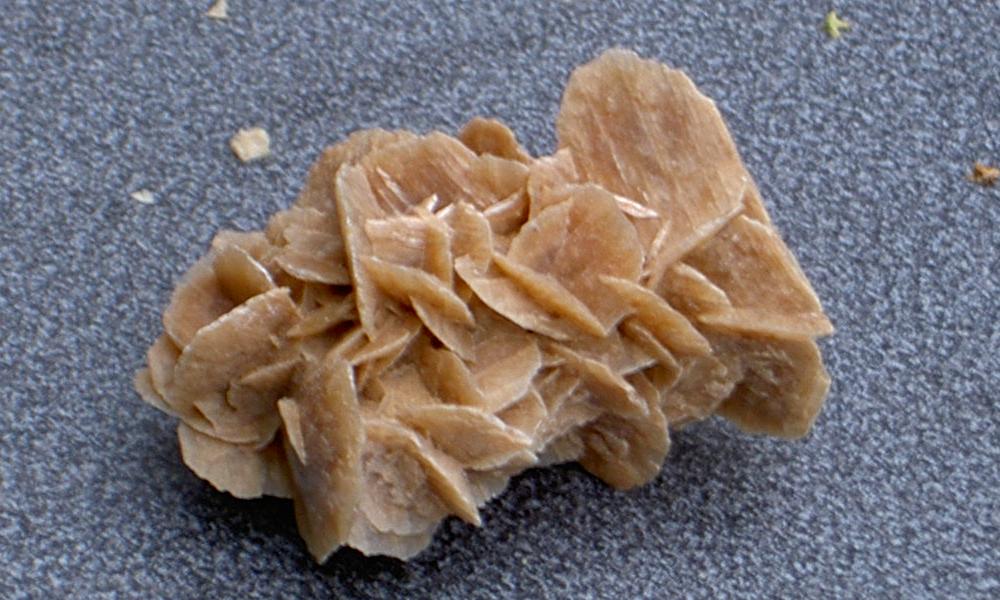- Gypsum
Infobox mineral
name = Gypsum
category = Mineral
boxwidth =
boxbgcolor =

caption = Desert rose, 10 cm long
formula = Calcium Sulfate CaSO4·2H2O
molweight =
color = White to grey, pinkish-red
habit = Massive, flat. Elongated and generally prismatic crystals
system = Monoclinic 2/m
twinning = common {110}
cleavage = good (66° and 114°)
fracture = Conchoidal, sometimes fibrous
mohs = 1.5-2
luster = Vitreous to silky, pearly, or waxy
refractive = α=1.520, β=1.523, γ=1.530
opticalprop = 2V = 58° +
birefringence =
pleochroism = None
streak = White
gravity = 2.31 - 2.33
melt =
fusibility = 3
diagnostic =
solubility = hot, dilute HCl
diaphaneity = transparent to translucent
other =
var1 = Satin Spar | var1text = Pearly, fibrous masses
var2 =Selenite | var2text = Transparent and bladed crystals
var3 =Alabaster | var3text = Fine-grained, slightly coloredGypsum is a very soft
mineral composed ofcalcium sulfate dihydrate, with thechemical formula CaSO4·2H2O. [Cornelis Klein and Cornelius S. Hurlbut, Jr., 1985, "Manual of Mineralogy", John Wiley, 20th ed., pp. 352-353, ISBN 0-471-80580-7]Crystal varieties
Gypsum occurs in nature as flattened and often twinned
crystal s and transparent cleavable masses calledselenite . It may also occur silky and fibrous, in which case it is commonly called "satin spar". Finally it may also be granular or quite compact. In hand-sized samples, it can be anywhere from transparent to opaque. A very fine-grained white or lightly-tinted variety of gypsum is calledalabaster , which is prized for ornamental work of various sorts. In arid areas, gypsum can occur in a flower-like form typically opaque with embedded sand grains called desert rose. The most visually striking variety, however, is the giant crystals fromNaica Mine . Up to the size of 11m long, these megacrystals are among the largest crystals found in nature. A recent publication shows that these crystals are grown under constant temperature such that large crystals can grow slowly but steadily without excessivenucleation . [cite journal |author=Juan Manuel García-Ruiz, Roberto Villasuso, Carlos Ayora, Angels Canals, and Fermín Otálora |title=Formation of natural gypsum megacrystals in Naica, Mexico |journal=Geology |volume=35 |issue=4 |pages=327–330 |year=2007 |doi=10.1130/G23393A.1]Occurrence
Gypsum is a common mineral, with thick and extensive
evaporite beds in association withsedimentary rock s. Deposits are known to occur in strata from as early as thePermian age. [Barry F. Beck, Felicity M. Pearson, P.E. LaMoreaux & Associates, National Groundwater Association (U.S.), "Karst Geohazards: Engineering and Environmental Problems in Karst Terrane", 1995, Taylor & Francis, 581 pages ISBN:9054105356] Gypsum is deposited in lake and sea water, as well as inhot spring s, from volcanic vapors, and sulfate solutions in veins.Hydrothermal anhydrite in veins is commonly hydrated to gypsum by groundwater in near surface exposures. It is often associated with the mineralshalite andsulfur .The word gypsum is derived from the
aorist form of the Greek verb "μαγειρεύω", "to cook", referring to the burnt or calcined mineral. Because the gypsum from the quarries of theMontmartre district ofParis has long furnished burnt gypsum used for various purposes, this material has been calledplaster of Paris . It is also used in foot creams, shampoos and many other hair products. It is water-soluble.Because gypsum dissolves over time in water, gypsum is rarely found in the form of sand. However, the unique conditions of the
White Sands National Monument in the US state ofNew Mexico have created a 710 km² (275 square mile) expanse of white gypsum sand, enough to supply the construction industry withdrywall for 1,000 years.cite news | last = Abarr | first = James | title = Sea of Sand | pages = | publisher = The Albuquerque Journal | date =1999-02-07 | url = http://www.abqjournal.com/venue/travel/tourism/heritage_whitesands.htm | accessdate = 2007-01-27 ] Commercial exploitation of the area, strongly opposed by area residents, was permanently prevented in 1933 when presidentHerbert Hoover declared the gypsum dunes a protected national monument.Commercial quantities of gypsum are found in
Jamaica ,Iran ,Thailand ,Spain (the main producer inEurope ),Germany ,Italy ,England ,Ireland , inBritish Columbia ,Manitoba ,Ontario ,Nova Scotia and Newfoundland inCanada ,cite web|url=http://mmsd1.mms.nrcan.gc.ca/mmsd/producers/commodityCompany_e.asp?nId=51&mineType=nonMetal |title=Mines, Mills and Concentrators in Canada |accessdate=2007-01-27 |date=2005-10-24 |publisher=Natural Resources Canada ] and inNew York ,Michigan ,Indiana cite web|url=http://www.mindat.org/loc-24903.html ] ,Texas (in thePalo Duro Canyon ),Iowa ,Kansas ,Oklahoma ,Arizona ,New Mexico ,Colorado ,Utah andNevada in theUnited States . There is also a large mine located atPlaster City , California in Imperial County, and in East Kutai,Kalimantan .Vast crystals of gypsum, up to 10 metres in length have been found in the "Cueva de los Crystales" in Naica,
Chihuahua ,Mexico . [ [http://naica.laventa.it/naica-crystal-cave.en.html NAICA, Cueva de los Cristales, Cave of the Crystals, in the Naica-Peñoles mine, cave of largest selenite (gypsum) crystals in Naica | La Venta Exploring Team ] ]Uses of Gypsum
There are a large number of uses for gypsum throughout
prehistory andhistory . Some of these uses are:
*Drywall
*Plaster ingredient.
*Fertilizer andsoil conditioner . In the late eighteenth and early nineteenth century, Nova Scotia gypsum, often referred to as plaister, was a highly sought fertilizer for wheat fields in the United States.
*A Binder in Fast-Dry tennis court clay.
*Plaster of Paris (surgical splints; casting moulds; modeling).
*A wood substitute in the ancient world; for example, when wood became scarce due to deforestation onBronze Age Crete , gypsum was employed in building construction at locations where wood was previously used. [ [http://letmespeaktothedriver.com/site/10854/knossos.html#fieldnotes C. Michael Hogan, "Knossos fieldnotes", Modern Antiquarian (2007)] ]
*Atofu (soy bean curd) coagulant, making it ultimately a major source of dietarycalcium , especially inAsia n cultures which traditionally use fewdairy products .
*Adding hardness to water used forhomebrewing .
*Blackboard chalk.
*A component ofPortland cement used to prevent flash setting of concrete.
*Soil/water potential monitoring (soil moisture tension)
*A medicinal agent intraditional Chinese medicine called Shi Gao.References
External links
* [http://webmineral.com/data/Gypsum.shtml WebMineral data]
* [http://www.mindat.org/min-1784.html Mineral Data from Mindat]
* [http://mineral.galleries.com/minerals/sulfates/gypsum/gypsum.htm Mineral Galleries- Gypsum]
* [http://www.mindat.org/loc-24903.html U.S. and National Gypsum Co. mines, Shoals, Martin Co., Indiana, USA]
Wikimedia Foundation. 2010.
